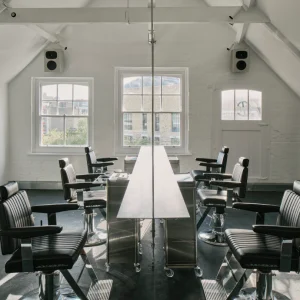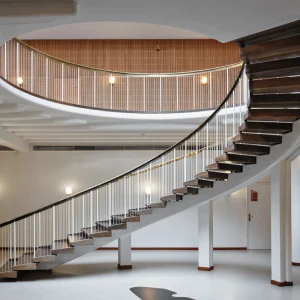Lighting can account for up to 70 per cent of a small to medium retail outlet’s energy cost, according to data from Hoare Lea, which has collaborated with Land Securities on its new Low Carbon Fit Out Guide for the retail sector. For department stores it’s around 60 per cent.
Green issues aside, it would seem to be a significant chunk of expenditure that might bear closer examination in the highly competitive, margin-pared high street. But it’s more complicated and counterintuitive than that, particularly when it comes to fashion outlets, says lighting designer Paul Nulty. Like other lighting consultants, he is trying to steer stores away from lighting energy profligacy.
‘Retailers are typically not looking much more than three years ahead,’ says Nulty, whose clients have included Nike, Superdry and DKNY. ‘They couldn’t care less whether they’re paying for 15W/sq m or 50W/sq m. If they have to use more energy, have higher electricity bills and higher maintenance costs but it means they’re going to create better instore experiences and sell more product, then frankly they’re going to do it. Saving energy costs is definitely not a priority.
‘The only way any retailer is ever going to take on board a reduction of light levels and a reduction of energy consumption is if you can prove that it directly affects the bottom line, either by more sales or reduced bills, but usually more sales.’
That view is rather predicated on the idea that energy efficient lighting somehow equates to an inferior interior. This is despite ceramic metal halide having been a stalwart of the retail sector for some years, and that LEDs are touted as the energy panacea. With the current emphasis on selling the instore experience in order to beat off online competition, some retailers are convinced that only incandescent sources can create a truly attractive ambience.
One trend that appears on the surface to be helpful in reconciling reduced energy use with creating the requisite consumer experience is the move towards the edgier, gloomier, nightclub aesthetic that Abercrombie and Hollister have pioneered. Says Nulty: ‘For the past 10 years the mindset has been that Joe Bloggs next door has 1000 lux so I need 1200 lux because I need to compete, so there has been this sort of arms race.’ ‘I think Abercrombie bursting on to the scene has made people think about light levels and quality of light in a space. Companies are realising that to be different they don’t have to be brighter. I think they represented a bit of a watershed moment for the retail lighting industry.’
This aesthetic is spreading outside the fashion sector. ‘We’re working with a brand outside of fashion and the scheme we’re doing is very moody, very dark and will surprise a lot of people,’ says Nulty. ‘I hear that even Tesco is looking at lighting its stores in a fairly moody way, with a greater emphasis on merchandise, less emphasis on circulation. Even though you’re trying to create mood and ambience you’re still trying to retain focus on merchandise. At the end of the day you don’t sell floors, ceilings or walls, you sell merchandise so why light the floor?’
The irony is that despite pioneering this moodier look, Abercrombie insists on using incandescent (although PNLD managed to persuade Superdry that it could achieve the same look with ceramic metal halide). But other retailers are convinced that LEDs can meet both aesthetic and energy efficiency goals – there has been a whole raft of announcements recently trumpeting the triumph of LEDs. Next, Pret A Manger and New Look are among the major chains to have recently declared their intention to make the switch from traditional source to solid state technology. Clearly they believe the move adds up for the bottom line.
In what is believed to be the UK’s biggest retrofit LED deal, Next has ordered more than 110,000 LED luminaires. Projection Lighting landed the largest slice of the order with a £4m deal to supply 90,000 AlphaLED fittings using Xicato LED modules (a remote phosphor technology that gives a more halogen-like effect). These will replace all of its 12V 35W IRC dichroic lamps in UK.
According to trials that Projection conducted at six stores with 3,000 fittings, aside from lighting energy savings, air conditioning costs were cut by 34 per cent. Payback was estimated at between two and three years.
The halogen lamps in 600 New Look stores will be replaced by Rexel in a deal worth £650,000. The return on the investment will be delivered in just 15 months, says Rexel, with reduced energy consumption and lower maintenance costs.
The Xicato modules used in the Next fittings will also figure in a scheme that Fagerhult has developed for Pret A Manger. This involves 90 per cent LED fittings – primarily Pleiad G3 LED downlights with Dali drivers – which is being rolled out for 50 refits and some 25 new stores this year. The scheme not only shows greatly improved efficiency – cutting 80 per cent of the energy used at certain times of day – but also allows Pret A Manger to resolve an ambience issue. Probably the first roll-out of dimmable LED lighting to any major retailer in the UK, the control system enables four different lighting scenes for different times of day. This has helped boost the evening offer and the shoulder periods between the breakfast and lunch offers.
M&S, which has boldly declared its ambition to become the world’s most sustainable major retailer by 2015, considers LEDs as a key factor in achieving environmental nirvana. A range of Philips LED fittings has been installed across the car park, back of house and shop floor at its Sustainable Learning store at Ecclesall Road, Sheffield. The aim is a reduction in energy usage of between 25-30 per cent from the light fittings alone, with further cuts through the control system. ‘LED lighting is an important part of our energy reduction strategy and provides bright, consistent light levels which really complement our products,’ says Richard Gillies, director of Plan A, sustainable business and CSR at M&S.
But most lighting designers would argue that the answer doesn’t lie exclusively with LEDs either and that while they are ideal for linear applications, their implementation is premature when it comes to display lighting. ‘Edge lighting, undershelf lighting – anything that’s not from a great distance – is fine,’ says Chad Raines of Illumination Works, who numbers Paul Smith and Marc Jacobs among his clients. ‘But if you have a 3m height and you want to attract someone to a display, then I wouldn’t use LEDs at the moment.’
This lack of accent punch remains a significant drawback despite various manufacturers having announced long-awaited narrow-beam optics at the world’s largest lighting show in Frankfurt this year. ‘Typically we would look at remote phosphor, but the fundamental problem is that you still can’t get a tight beam out of it,’ says Nulty, whose recent scheme for DKNY in Bond Street, London was virtually all-LED (the interior designer snuck in some Tom Dixon incandescent pendants). ‘The thing is they’re about as good as a glow worm’s fart – 700-800lm is not punchy enough, you need something more like 2500lm.
‘For DKNY we really struggled to find fittings and in the end opted for a slightly wider beam. People keep telling us they’ve cracked it and you see these fittings that are supposed to be 10-degree beams, but what you get is a 40-degree beam with a 10-degree hot spot in the middle.’
There’s also the capital cost issue. Because DKNY refurbs on average every seven to 10 years, LEDs were easier to justify on both efficiency and maintenance grounds. Most retailers have a more frequent refurb cycle, and while the case can be made for maintenance savings, payback on fittings that can be twice the price of traditional counterparts is more difficult to justify.
‘One client wants to be green and maintenance efficient and is always wanting to move towards LEDs, but when they look at the price they go back to halogen and decide to wait until the next project,’ says Raines. ‘They keep punching it down the line.’
Russell Lipscombe of Office of Light, who has done schemes for Moss Bros, Hamleys, Harrods and Victoria’s Secret, says that – for the time being – the solution to covering all the efficiency, cost and maintenance bases, while still creating an attractive ambience, usually lies in a judicious mix of LEDs with traditional sources, particularly ceramic metal halide. ‘At Burberry, for example, we’ve used LEDs in all the coffers and for other architectural lighting, but the economics of it means that we’re still using miniature metal halides for the display lighting. And you get more of a buzz from the directionality of a metal halide lamp.’
He believes that while some retailers may still be clinging to incandescent while others see LEDs as their energy saviour – and can justify the capital outlay by the sheer scale of their operations – the majority of high street retailers recognise that the discharge source is still the optimum solution.
‘We have to be concerned about energy saving and we have to educate retailers to accept slightly lower levels of light and slightly less intensity,’ says Lipscombe. ‘But there’s so much competition on the high street at the moment that all the various retailers are competing against each other and they want the best effect. At the moment most of them think that they can do that with metal halide.’
Lighting control
As well as selecting the most efficient lamp and luminaire combinations (and carefully selecting and zoning light levels to suit the shop floor), controls are a vital part of an efficient lighting system and ensure lighting is only used when needed. There are three key areas to consider:
- Shop front lighting control should be separated from the shop floor lighting and put on a time-clock control to switch off during the night. The shop front lighting could also be varied depending on the amount of daylight. External retail frontage does not require the same level of illumination at night as it does during the day, so lower illumination levels and subsequently less power could be used at night while still providing high contrast and attracting custom.
- Shop floor lighting should be off when the shop is not occupied. This can be achieved by a combination of timers, movement sensors and/or ‘last person out’ switches. Traditionally shop floor lighting remains constant during the day, but could be designed to react to external daylight conditions or customer use. Lighting levels can also be reduced while restocking the shop floor, simply by switching off every other luminaire or a row of luminaires. The circuiting of the lighting should be designed to allow this to happen. Alternatively, more sophisticated means of control such as Dali (digital addressable lighting interface) could be used to achieve this.
- Back-of-house lighting should be automatically controlled by movement sensors to ensure that they are only used when required.
From Low Carbon Fit Out: Retail 2012 (Land Securities/Hoare Lea)
Links: paulnulty.co.uk
illuminationworks.com
officeoflight.com
Low-Carbon-Fit- Out- Guide-Retail-2012: landsecuritiesretail.com/about-us/case-studies





